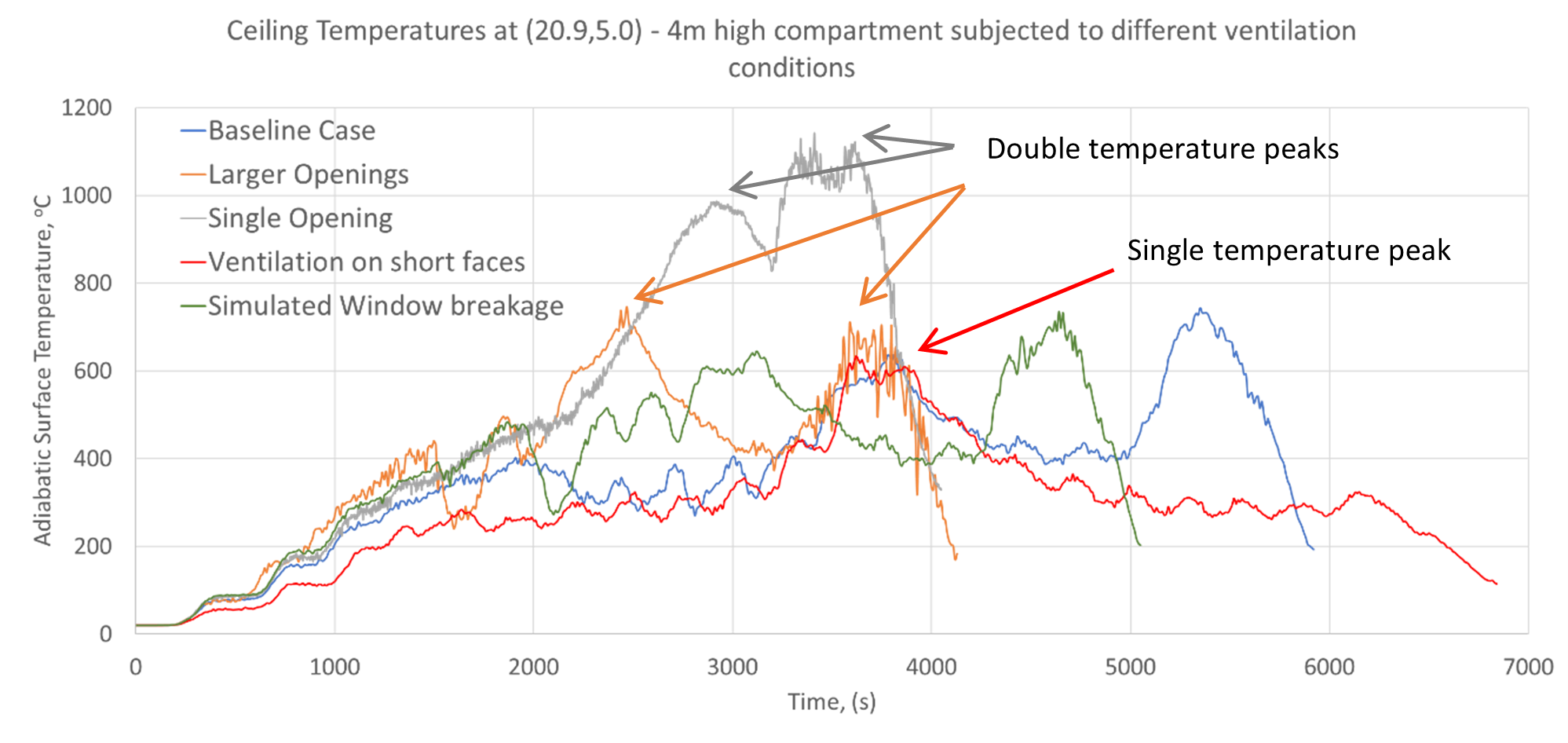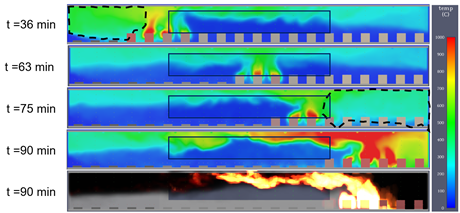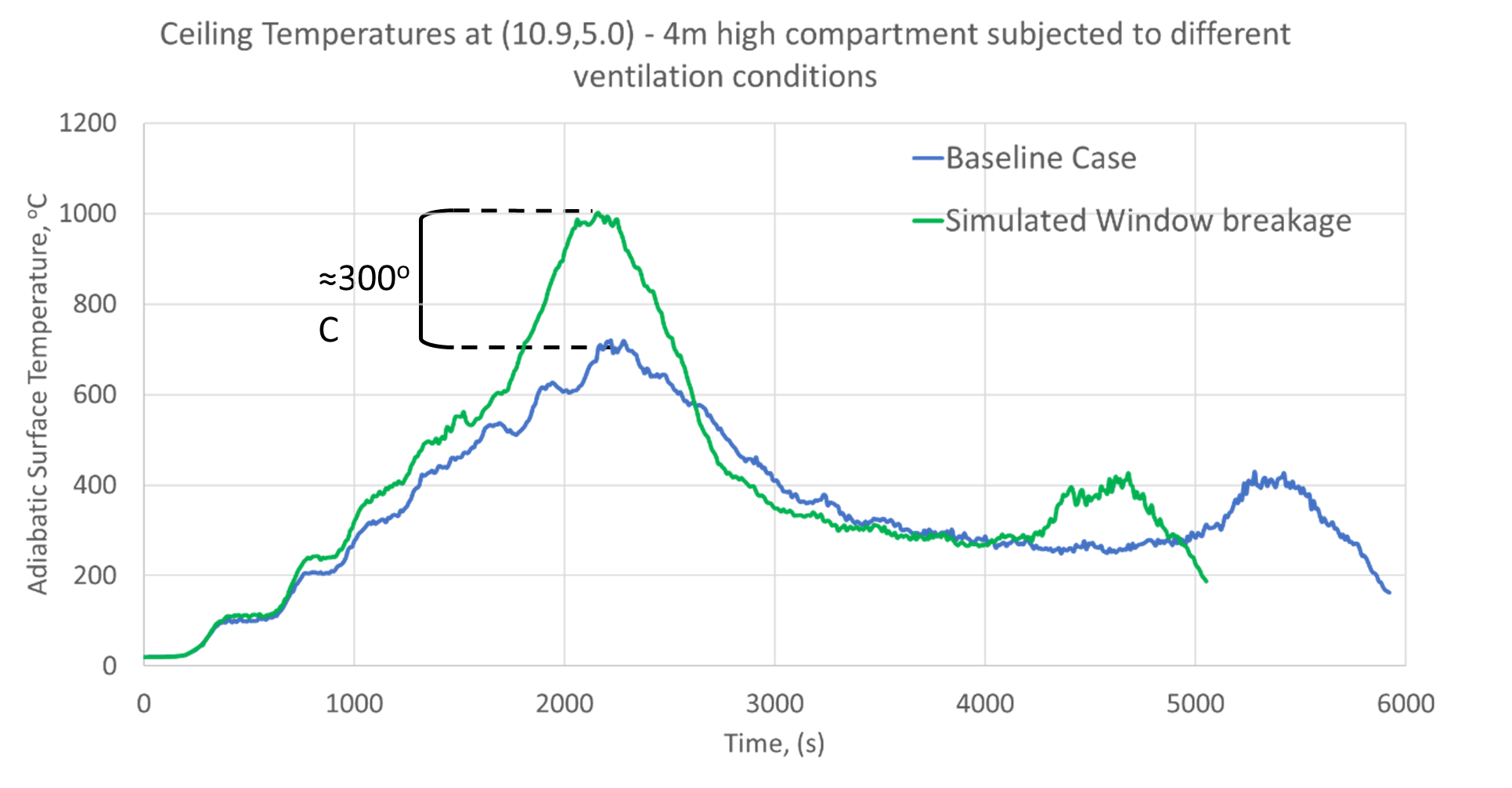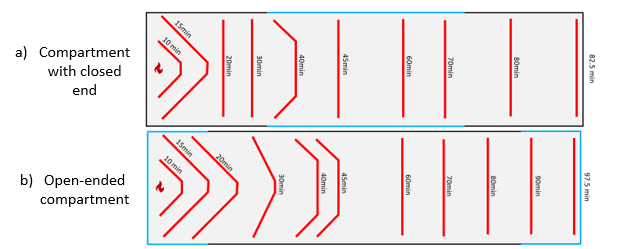
View the PDF here
Analysis of Travelling Fires and Comparison to the Travelling Fire Methodology
Vinayagum Reyalen Ramsamy1, Emmanuel Annerel2,3, Karim Van Maele2, Georgios Maragkos3 and Bart Merci3
1International Master of Science in Fire Safety Engineering (www.imfse.be) -reyalenramsamy@gmail.com
2Etex Innovation and Technology Centre, Etex Building Performance, (www.etexgroup.com)
3Ghent University – UGent; Faculty of Engineering and Architecture; Department of Structural Engineering and Building Materials
Context
As open-plan compartments become increasingly common in the built environment, it has become important to understand travelling fire behaviour in the context of fire safety. In contrast to the behaviour of a fire in a small compartment, travelling fires are characterised by a flame front that progressively spreads across the enclosure, leading to regions of high and low temperatures, at different points in time and space. Such a fire behaviour has been observed both experimentally in Cardington [1] and Dalmarnock fire tests [2], as well as in accidental fires in large compartments, such as the Ghost Ship Warehouse Fire in the U.S.A in 2016 [3], TU Delft in the Netherlands in 2008 [4], the Windsor Tower in Spain in 2005 [5] and the World Trade Center in New York in 2001 [6]. Although the parametric temperature-time curve in Eurocode 1 [7] addresses the transient nature of the temperature within a compartment, it does not capture important phenomena related to travelling fires, such as a pre-heating phase of structural elements due to smoke movement prior to flame impingement.
Bearing in mind that sound fire safety design of structural elements relies upon a realistic time-temperature curve, this study attempts to evaluate the adequacy of new fire models proposed in literature, such as the Travelling Fire Methodology (TFM) [8], using CFD analysis. In this paper, the findings of a numerical study of travelling fires using the Fire Dynamics Simulator (FDS, Version 7.6.0) [9] software are summarized. Different ventilation and geometry configurations as well as dynamic ventilation changes during the fire event are simulated; a comparison of some of the findings is performed with respect to what is suggested by the TFM. The full version of the MSc thesis can be found on [10].
FDS Simulations Set-up
To capture travelling fire behaviour, a compartment of 40m by 10m was constructed, based on a previous CFD study on travelling fires [11]. The position and sizes of the openings were varied to investigate their impact on the fire spread. The cases studied are summarised in Table 1. For computational reasons, the mesh size used was set at 20 cm. It is acknowledged that the 20 cm mesh cannot provide accurate temperature predictions (i.e. the maximum temperatures are underestimated) but allows to study the temperature-time trends observed in travelling fires. A mesh sensitivity study and its implications are given in [10].

The individual fuel packages were modelled based on the burning characteristics of wooden pallets. A critical temperature for ignition of wood (set to 300oC) is used as the trigger for flame spread between fuel packages: each fuel package ignites automatically once the surface temperature reaches the critical value.
Analysis of Travelling Fire Behaviour as Function of the Ventilation Openings
The adiabatic surface temperature at several points situated at the ceiling height were recorded and analysed. The comparison of different ventilation opening conditions revealed significantly disparate temperature-time profiles for the same fuel set-up (Figure 2). Multiple cases exhibited a double temperature peak, attributed to the presence of a closed space at the end of the compartment. In such cases, the first peak corresponded to the moving flame front lying directly below the measurement device, while the second was caused by a ‘localised flashover’ as the fire reaches the end of the compartment.

|
Figure 2 Adiabatic Surface Temperature for different ventilation conditions showing varying temperature-time profiles. The measurement device is located at the centre of the compartment and at ceiling height (4m).
|
Figure 3 clearly shows how smoke accumulation at the closed end of the compartment lead to rapid ignition of multiple fuel packages at once (t=75min) causing severe flame impingement on the ceiling. The end-of-compartment flashover is absent in the simulation with an open-ended enclosure resulting in a single temperature peak: minimal amounts of smoke are trapped within the compartment. Instead, a bidirectional flow regime was observed as shown in Figure 4.

|
Figure 3 Temperature slice of compartment (baseline case) showing accumulation of smoke in the closed ends of the compartment leading to localised flashover of unburnt fuel packages (t=75min) (denoted by dotted polygons)
|
 Figure 4 Flow field at end compartment for an open-ended compartment and compartment with closed end.
Figure 4 Flow field at end compartment for an open-ended compartment and compartment with closed end.
One of the simulations modelled the effect of an initially closed window, assumed to break, and fall out completely upon reaching 300oC. The results were compared with those of the same compartment with fully open windows throughout the fire. The comparison showed temperature differences of up to 300oC between the two scenarios, emphasizing the strong impact of ventilation conditions, not only at the start of an enclosure fire, but also during the course of the fire event. The findings also identify this behaviour as a potential barrier to developing reliable temperature-time predictive methodologies when ventilation conditions are not considered.

Figure 5 Temperature-time profiles of compartment with closed breakable windows v/s compartment with opened windows. Higher peak temperature and shorter burnout time observed in initially closed breakable window case.
Analysis of the fire progress of different scenarios simulated showed that the fire spread rate was not constant during the fire event. Rather, it varied significantly depending on local ventilation conditions. In Figure 6 a), it varied from 6.7mm/s and peaked at 40mm/s when the flame front approached the openings, whereas in b) the fire spread rate remained relatively constant at 6.7mm/s during the entire fire event.

|
Figure 6 Mapping of flame front at different time stamps. The light blue border indicates the position of the windows. The tunnel-like geometry in b) leads to a more uniform fire spread rate because a steady by directional flow regime is established.
|

Comparison of the outcome of Eq. (1) to the CFD simulation results revealed that the TFM produced reasonable predictions as long as the actual fire spread rate remained relatively constant during the entire fire event, which was only the case in the open-ended compartment scenario. TFM yielded underpredicted far-field temperatures due to its inherent assumption of an unconfined ceiling (relying upon Alpert’s correlation). The TFM could not predict the second temperature peak observed in the scenarios with closed ends, thus diverging significantly from the simulation results.

|
Figure 7 Temperature time profile and TFM prediction for open-ended compartment and baseline case showing that the scenario with a uniform fire spread rate also generates more realistic predictions. Note the end of compartment flashover is not predicted by the TFM and is out of phase due to the varying flame spread rate.
|
Conclusions
Having inferred from numerical results the strong influence of ventilation conditions on both the extent and speed of fire spread, it is evident that further research and experimental work is needed to reinforce current temperature-time predictive methods. This study showed that events such as window breakages could significantly change the fire development, reiterating the complexity of fires in large enclosures. Although it is acknowledged that the computational requirements are limiting factors in the accuracy of the numerical simulations, the TFM did not conservatively predict the thermal exposure of the ceiling in the simulations as run. While the inferences made so far are substantiated through the numerical study, the need for validation experiments coupled with refined simulations are critical to a better understanding of travelling fires.
Acknowledgment
This article is based on the research conducted for the thesis “Analysis of Travelling Fires using CFD Simulations and Comparison to the Travelling Fire Methodology” submitted for the degree of The International Master of Science in Fire Safety Engineering (IMFSE) – www.imfse.be. The corresponding author gratefully received a scholarship from EACEA for his IMFSE studies.
References
[1] B. R. Kirby, D. E. Wainman, L. N. Tomlinson, T. R. Kay, and B. N. Peacock, “Natural Fires In Large Scale Compartments,” Int. J. Eng. Performance-Based Fire Codes, vol. 1, no. 2, pp. 43–58, 1999.
[2] J. Stern-Gottfried, “Travelling Fires for Structural Design,” Fire Saf. J., vol. 54, pp. 74–85, 2011.
[3] Oakland Fire Department, “Origin and cause report Incident #2016-085231,” Oakland, 2017.
[4] M. D. Engelhardt et al., “Observations from the fire and collapse of the faculty of architecture building, delft university of technology,” Struct. Congr. 2013 Bridg. Your Passion with Your Prof. - Proc. 2013 Struct. Congr., no. January 2017, pp. 1138–1149, 2013.
[5] I. A. Fletcher, S. Welch, D. Alvear, M. Lazaro, and J. A. Capote, “Model-based analysis of a concrete building subjected to fire,” in Advanced Research Workshop on Fire Computer Modelling, 2007, no. October.
[6] T. P. McAllister, “Structural Fire Response and Probable Collapse Sequence of the World Trade Centre Building 7,” Washington, 2008.
[7] Eurocode 1: Actions on Structures Part 1-2 General Actions - Actions on structures exposed to fire, vol. 1–2. 2002.
[8] J. Stern-Gottfried, A. Law, G. Rein, M. Gillie, and J. L. Torero, “A Performance Based Methodology Using Travelling Fires for Structural Analysis,” in 8th International Conference on Performance-Based Codes and Fire Safety Design Methods, 2010.
[9] “FDS-SMV.” [Online]. Available: https://pages.nist.gov/fds-smv/. [Accessed: 17-Apr-2020].
[10] “Theses — IMFSE.” [Online]. Available: https://imfse.be/theses. [Accessed: 26-Aug-2020].
[11] M. Charlier, A. Gamba, X. Dai, S. Welch, O. Vassart, and J.-M. Franssen, “CFD analyses used to evaluate the influence of compartment geometry on the possibility of development of a travelling fire,” in Conference Proceedings of the 10th International Conference on Structures in Fire 2018, 2018, p. 1036.
[12] E. Rackauskaite, C. Hamel, A. Law, and G. Rein, “Improved Formulation of Travelling Fires and Application to Concrete and Steel Structures,” Structures, vol. 3, pp. 250–260, Aug. 2015.